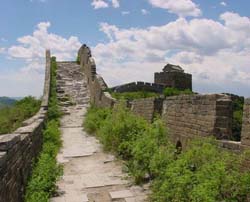 The Great Wall is the universal symbol of China. Starting from the eastern Shanhaiguan Pass, and ending at the Jiayuguan Pass in the west, the Great Wall fully merits its designation as a wonder of the world. In Hebei Province alone, it runs for 2,000 kilometers, through more than 200 passes. The Jinshanling Great Wall lies in the mountainous area of Luanping County, Hebei Province, and has a total length of 10.5 kilometers.
The Great Wall is the universal symbol of China. Starting from the eastern Shanhaiguan Pass, and ending at the Jiayuguan Pass in the west, the Great Wall fully merits its designation as a wonder of the world. In Hebei Province alone, it runs for 2,000 kilometers, through more than 200 passes. The Jinshanling Great Wall lies in the mountainous area of Luanping County, Hebei Province, and has a total length of 10.5 kilometers.
Essence of the Great Wall
The Jinshanling Great Wall was first built in the sixth century during the Northern and Southern Dynasties (420-589). Along it are 67 watchtowers, all in different styles, at average intervals of 150 meters.
During the Ming Dynasty, General Qi Jiguang improved the structure of the Jinshanling Great Wall by making it higher and denser and by building double walls at strategic sections. Its gentle gradient makes Jinshanling a vulnerable spot, easy to attack but difficult to defend. At the Jinshanling section of the Great Wall, however, the walls are more solid, and the watchtowers taller, and more concentrated. Viewed from a distance, the Jinshanling Great Wall is like a giant dragon, curving its path over the mountain peaks whose line it follows.
Many Great Wall researchers and cultural relics experts, including Luo Zhewen and Zhu Xiyuan, have been coming to Jinshanling since 1980, and consider it to be of strategic importance, great aesthetic value, and to reflect the very essence of the Great Wall.
Photographers' Favorite
Photographers know that the best place to take pictures of the Great Wall is not Badaling or Shanghaiguan, but Jinshanling. The Great Wall from Simatai in Beijing to Jinshanling in Hebei is the best preserved stretch, so many overseas visitors choose it. It is said that there are more overseas Great Wall climbers in Jinshanling than Chinese. People also say that anyone who has climbed Jinshanling is not interested in seeing any other part of the Great Wall, as it retains its original Ming Dynasty outlook, and so vividly reflects the full ethos of that epoch.
Members of the Great Wall Green Project Investigation Group have walked the entire length of the Great Wall, and many of them believe Jinshanling to be its most beautiful section. Not having been fully renovated, parts of it are in ruins, so it has a more natural ambience than other stretches of the wall that have been completely rebuilt. Jinshanling is far less crowded than Badaling or the Shanhaiguan Great Wall, thus giving today's climbers a hint of the isolation that must have been felt by its ancient defenders.
Zhou Wanping is a photographer who lives at the foot of the Jinshanling Great Wall. In the preface to his published photograph album, My Home Town, he says: "At the time I graduated from high school and went home, the Jinshanling Great Wall was being repaired. Although sick, I participated in the renovation process along with other villagers. This experience fully brought home to me the hardship involved in the original construction of the Great Wall. All the bricks, lime and water needed for construction had to be carried to the site on the backs of laborers."
Chinese imperial dynasties appeared, prospered and died out through history. The Great Wall bears witness to their vicissitudes, and demonstrates the Chinese people's hard working spirit, and the splendid culture and history of the Chinese civilization.
transportation: Take long-distance bus at Beijing's Dongzhimen bus station to Miyun county first, then take mini bus to Jinshanling tour area.
Ticket: 30 yuan (US$3.6)
(China Today March 5, 2003)
|

